
Congratulations on choosing DriverActive for your 'test pass journey'!
Spending a five minutes reading this introduction will help to make sure that you make the best use of DriverActive and maximise your chances of an early driving test pass.
This introduction will be useful even if you already have a Provisional Licence and have booked or started your driving lessons.
If you are already taking lessons skip the 'choosing an instructor' bit.
Although if you are uncertain about your instructor read the information. Driving lessons are any other service that you buy - if you are uncertain or uncomfortable with your instructor or unhappy with your progress try someone else.
 Make sure that you are comfortable with your instructor and be prepared to change if you are not!
Make sure that you are comfortable with your instructor and be prepared to change if you are not!
Buying driving lessons is no different from getting value for money from your local supermarket. If you are not happy with something you buy - don't buy it again!
We all learn in different ways, but it is your instructor's job to make your learning experience as enjoyable and easy as possible.
If you are struggling, it might well be your instructor's lack of skill rather than your lack of aptitude and ability. Or it might simply be that there is a bit of a 'personality clash'.
By their very nature, the vast majority of instructors are 'nice people' but remember that you are not paying someone to be 'nice', you are paying them to teach you to drive safely and to do it in a way that you are happy and comfortable with.
Sometimes it can feel awkward leaving an instructor - especially if they are friendly and helpful... But remember that you are the customer - and learning to drive is a very important purchase. Getting the right instructor will save you time and money and probably make you a better driver.
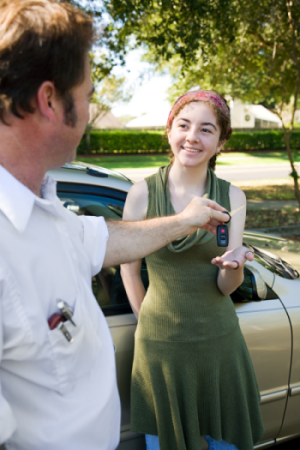
Some people learn to drive with friends and relatives, but with the busy traffic and complex rules on modern roads it's wise for all new drivers to have some lessons with a professional instructor, even if they have an opportunity to drive at home.
When looking for an instructor you need to make sure they are qualified. In the UK this means that the instructor must be approved by the Driver and Vehicle Standards Agency (DVSA).
If you are live outside the UK check the local regulations to make sure that you have an instructor who is qualified to do the job.
Important: In the UK it is illegal for anyone who is not a fully qualified Approved or Licensed driving instructor to charge a fee for driving tuition. If you knowingly pay money to an unlicensed instructor you could also be liable for aiding an offence.
Your instructor will guide you carefully through your training and ensure that you are fully prepared to drive safely after passing your test.
You might find that some of the things your instructor tells you differ from the way your parents or friends drive - this has nothing to do with learning a certain way to pass the test, it's about safety when driving modern cars.
Different vehicle design often needs a different driving approach. A major example is the use of gears in a manual car - people who passed the test fifteen or twenty years might well have been taught to change each gear in sequence - this is no longer required with modern vehicles. Or someone might tell you that you don't need the handbrake when you stop or park in a car with automatic transmission - you do!

Approved Driving Instructors (ADI) have passed a searching examination in order to demonstrate their skills, they are also checked and graded regularly and have undergone a Criminal Records Check.
You can recognise an ADI because he/she will display a green badge in the tuition vehicle's front windscreen (this must be displayed by law while teaching).
Instructors are graded as 'A' or 'B' with 'A' being the highest grade.
If instructors do not reach a satisfactory standard during their assessments they can have their licence to teach revoked.
Approved instructors are issued with a certificate which shows their grade, they should be happy to show this if asked.
If your instructor is reluctant to disclose his/her grade or to show proof when asked, you might be well advised to consider someone else. Claiming to be a Grade A when actually a Grade B or fail is a serious offence and could lead an instructor to being banned from teaching.
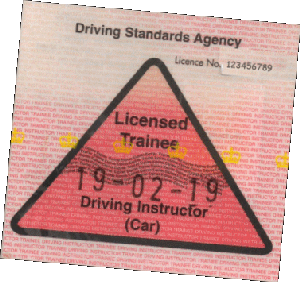
Licensed instructors are in the final stages of training and qualification. These instructors have undergone a minimum required training programme and but have not yet passed the final qualifying examination.
While Licensed instructors are expert drivers and have learned the basic teaching skills, they have less than six months experience in the job.
However, many Trainee instructors will make up for their lack of experience with their enthusiasm for their new career - some will also have had teaching experience in previous jobs.
You can recognise a Licensed instructor because he/she will display a pink badge in the windscreen (this must be displayed by law while teaching).
Your instructor's photograph will be displayed on the rear of badges. But a bit like passport photos, they might look like convicts!
Some instructors will have additional qualifications such as special advanced driving certificates, teaching diplomas and even industry related degrees.

Generally speaking, better qualified and experienced instructors will offer better value (although they might charge a bit more).
If this course has been recommended by an instructor who has supporting DriverActive materials (handouts, etc.), he/she is likely to be a member of the ADI MasterClass support web-site - these instructors get weekly training advice and industry updates to help ensure that they are fully up-to-date with teaching ideas and regulations.
DriverActive is structured so that you learn new skills in a logical, progressive order.
As you work through the course, each new skill is introduced to build naturally on what you have already learned. This will make your learning easy and enjoyable.

By using this course in conjunction with your practical training, you will get maximum value from every single minute that you spend behind the wheel. If you are doing most, or all, of your learning with friends or parents this course will guide both you and them and help overcome many of the common problems associated with learning 'at home'.
To gain the full benefit from DriverActive most people will find it best to work through the first two sections, Early Skills and Road Skills, in the order that they are shown on the menus - having said this, if you are having lessons with a professional instructor he/she might change the order of some things slightly.
Section three, 'Using Your Skills', presents a series of situations where you will use the skills learned in the earlier sections. Wherever possible, avoid the situations covered in section until you have completed the first two sections - doing this can be a bit of a problem in some areas, however, your driving instructor will be able to help.
The final two sections 'The Test' and 'After you pass' are fairly self-explanatory. The section about the driving test will make sure that you know exactly what to expect on the day - we have also provided some video clips from the DVSA that explain the test procedure.
'After you pass' has some information about driving alone for the first time and other useful tips.

As you work through DriverActive you will find a series of practical lessons, quizzes and useful information.
The best and quickest way to learn is by doing your training in small, easy steps.
In order to achieve this, ask your instructor what you will be covering next then view the relevant DriverActive lesson information and answer the quiz questions.
Some instructors will also give you DriverActive course handouts to help you to prepare for lessons and/or revise your knowledge after completing a lesson.
Each subject has a short quiz at the end. The quizzes are designed to help you to assess your own progress. However, you won't find a list of answers - all the answers can be found either on the same page as the quiz or in The Highway Code. Know Your Traffic Signs is another useful, free resource.
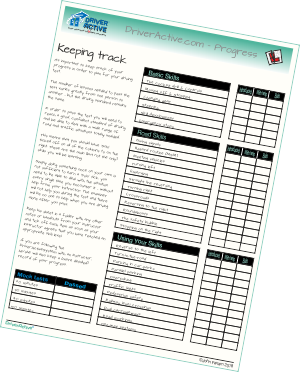 You are already discovering how DriverActive has been developed to help you to learn more quickly and to save you money on your practical lessons.
You are already discovering how DriverActive has been developed to help you to learn more quickly and to save you money on your practical lessons.
By reading about each lesson and completing the quiz questions before you go out in the car, you will gain more benefit from your practise. Reading the same information after your lesson will help you to remember and to better understand your positive experiences in the car.
Sometimes, a lesson in your car will include topics from more than one of the DriverActive lessons. On the other hand, you might take two or three lessons in the car to cover one online lesson. There is no fixed rule, every driver is different!
You can keep track of your progress using the DriverActive Progress Log.
As you work through DriverActive sign off each lesson when you become competent. You can use the quizzes and progress log in conjunction with your instructor or fill them in yourself.
Click here to download your progress log.
By signing off your lessons you will make sure that you always have a clear and objective view of where you are in the course and how long it is likely to be before you are ready for your driving test.
Keeping all of your printed quizzes and handouts together in a folder will help you track your progress and will become a handy reference book for revision.
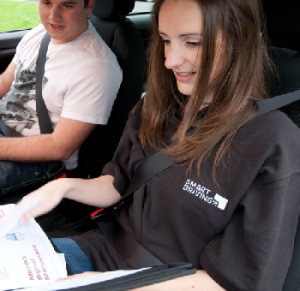
You will find lots of people willing to offer advice on the subject of how many lessons it takes to learn to drive, but the truth is - everybody is wrong! Simply because we all learn differently and at different rates.
People will offer advice and guidance in good faith, perhaps based on their own experience of learning to drive.
"You only need a few lessons to learn the test route' or 'I passed after 10 lessons – nobody needs more than that"
When you hear things like this it can leave you feeling a bit inadequate, especially if you are nearing your 50th lesson! It could even leave you feeling that your instructor is giving unnecessary tuition.
Perhaps the first thing to bear in mind is that driving is more complex than it used to be and so people take more lessons now than they did even ten years ago - no one (or at least perhaps just one in a million) passes the modern UK driving test with as little as ten hours driving. This might have been possible in 1976, but not now.
If someone who has passed recently tells you that they only had a few lessons they are either being dishonest, or neglecting to mention the 30 or 40 hours practise they did with Mum or Dad.
The reality is that people learn in different circumstances and at different rates; you are an individual and will learn at your own pace. There is no reliable formula for working out how long it will take to learn to drive; the number of lessons needed varies from person-to-person and from place-to-place.
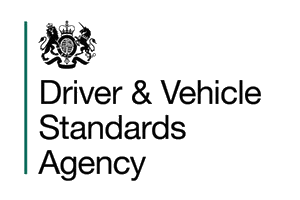
As a general rule, the older you are the longer it takes to learn. However, there are plenty of examples to prove this rule wrong. No matter what age you are, you should expect to take at least 30 hours training with a driving Instructor. If you are not able to practice in between lessons that figure will probably be at least double.
The Driver & Vehicle Standards Agency research has shown that on average people take around 45 hours with an instructor plus an additional 22 hours practice between lessons to reach driving test standard.
Often older people are surprised how long it takes to learn these days, but they forget - the test is much tougher than it used to be and the roads are much busier. Many 'experienced' drivers would fail the modern driving test miserably.

If you have an opportunity to practise driving between lessons you should take it. The more driving practise you can get, the quicker you will learn and pass your test, but, although you will learn quicker if you get more practise, I do have a word of warning...
When practising with friends or relatives, remember that they are the ones with the experience. Listen to their advice and act on it.
It's not unusual to hear stories of friends who have fallen out, family rows or even physical fights when people are learning with friends and relatives!
If the advice given by friends is different from that of your instructor, find out why. Get your friends to talk to your instructor about the most modern and efficient driving techniques and/or get them to look at the information in this programme.
You must be aware of some important things before you start to drive.
Perhaps the first and most important of all is to know that, as a driver, you are legally responsible for your vehicle, your own safety and the safety of all those around you.
This means that, even though you are learning, you have real responsibilities from the first time you sit behind the wheel. The more you can think like a driver, the quicker you will become one.
Suppose you are unlucky enough to crash your car or get stopped for speeding (or some other offence) during lessons. In that case, you will be liable for prosecution even though you only have a provisional licence. Your supervisor (or instructor) may also be liable for prosecution in some situations.
Before your first lesson, make sure that you are familiar with the information in this introduction - if you are not correctly licensed or cannot meet the minimum eyesight requirements, the instructor could cancel the lesson. Or the lesson will go ahead, but you won't get an opportunity to drive.
To be comfortable during lessons, wear comfortable everyday clothes - jeans, t-shirts, loose sweaters etc., the sort of clothes you would wear on a long car journey.
It's a legal requirement to wear clothing and footwear that enables you to control the car safely. Flat shoes are best for driving. Avoid high heels or very thick soles - these can make it difficult to control the pedals.
If you usually wear glasses or contact lenses and need them to pass the eyesight test (see below), you must wear them when driving. The best glasses to wear are light frames and clear glass. If possible, avoid spectacles with thick side arms because these can restrict your view to the sides. If you have varifocal glasses, ask your optician to ensure that they are suitable for driving.

Before driving a motor car, you must meet the following requirements:
You must be at least 17 years of age (unless registered disabled)
You must be in physical possession of a valid provisional licence (simply applying for a licence does not entitle you to drive)
You must be able to read a modern car number plate from a distance of 20 metres
You must comply fully with the conditions of your provisional driving licence
Any relevant medical condition must be declared to the DVLA (ask your instructor for more information if you are unsure)
You must be accompanied by someone over 21 years of age who has held a full driving licence for a minimum of three years
You must be correctly insured to drive. If in doubt, check with your insurance company
Must be legally roadworthy
Must be correctly taxed (Vehicle excise duty)
Must display clearly visible L plates to the front and rear (or D plates in Wales)
Cars displaying plates in Northern Ireland are restricted to 45 mph.
Must be properly insured for you to drive. If in doubt, check with your insurance company
Seatbelts help ensure the safety of the driver and passengers. The seatbelts cannot guarantee your safety – only safe driving can do that. However, they will significantly reduce your risk of serious injury.
.
You must:
Wear a seatbelt when driving (unless you are exempt)
Ensure that any passengers under the age of 14 comply with the requirements to wear a seatbelt or suitable restraint/booster cushion/child seat/baby-carrier
 There is no 'nice' way to explain this message.
There is no 'nice' way to explain this message.
Remember that you are responsible for everything you do behind the wheel, even during your driving lessons.
You should never drive while you are under the influence of drink or drugs (even some over the counter or prescription drugs). Attempting to drive while impaired can lead to a lifetime of guilt and misery if you kill another innocent road user, or you could kill yourself.
Some symptoms of drink and drugs are:
Impaired vision
Increased stopping distance
Slower the reactions and coordination
You feel over-confident, which causes the risks.
The chances are that you will feel OK driving after having a drink. You might even feel that you can drive better after a drink or when you are high. Sadly, graveyards are full of people who thought the same way. It's just not worth it.
At DriverActive, we don't want to tell you how to live your life when it comes to drinking and drugs; that's your affair. But please don't mix drink or drugs with driving. Some people will try to tell you that one or two drinks, a spliff or a couple of pills won't do any harm. Don't listen - drink and drugs mixed with driving can wreck your life and the lives of others.
It's not cool to end a night out in a body bag – it’s positively cold.
 Click here to complete the quiz for this lesson
Click here to complete the quiz for this lesson
(The page will open in a new window/tab)
You will find references for the answers in this lesson.
You can check your answers as you go along or complete the whole quiz before checking.
Leaving the check to the end is a great way to test yourself.
When you check or review your answers, we’ll give you a brief explanation of the answer.
Good Luck!